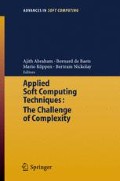Abstract
Medical semeiotics often deals with patient databases and would greatly benefit from efficient clustering techniques. In this paper a new evolutionary algorithm for data clustering, the Self–sizing Genome Genetic Algorithm, is introduced. It does not use a priori information about the number of clusters. Recombination takes place through a brand–new operator, i.e., gene–pooling, and fitness is based on simultaneously maximizing intra–cluster homogeneity and inter–cluster separability. This algorithm is applied to clustering in dermatological semeiotics. Moreover, a Pathology Addressing Index is defined to quantify utility of the clusters making up a proposed solution in unambiguously addressing towards pathologies.
Access this chapter
Tax calculation will be finalised at checkout
Purchases are for personal use only
Preview
Unable to display preview. Download preview PDF.
References
Babu GP, Murty MN (1993) A near–optimal initial seed value selection in k-means algorithm using a genetic algorithm, Pattern Recogn. Lett. 14(10):763–769
Bhuyan J, Raghavan V, Venkatesh K (1991) Genetic algorithm for clustering with an ordered representation. In: Belew R.K, Booker LB (eds) Proc. of the Fourth Int. Conf. on Genetic Algorithms (1991), pp. 408–415. Morgan–Kaufmann San Mateo
Blake CL, Merz CJ (1998) UCI Repository of machine learning databases: University of California, Irvine [http://www.ics.uci.edu/~mlearn/MLR,epository.html]
Burdsal B, Giraud–Carrier C (1997) Evolving fuzzy prototypes for efficient data clustering, www.cs.bris.ac.uk/Tools/Reports/Ps/1997-burdsall.ps
Goldberg DE (1989) Genetic algorithms in search optimization and machine learning. Addison–Wesley, Reading, Mass
Goldberg DE, Korb B, Deb K (1989) Messy genetic algorithms: motivation, analysis, and first results, Complex Systems 3:493–530
Guvenir HA, Demiroz G, Ilter N (1998) Learning differential diagnosis of erythemato–squamous diseases using voting feature intervals, Artificial Intelligence in Medicine 13:147–165
Han J, Kamber M (2001) Data mining: concept and techniques. Morgan Kaufman
Hand DJ, Mannila H, Smyth P (2001) Principles of data mining. MIT Press
Holland JH (1975) Adaptation in natural and artificial systems, 2nd edition. The University of Michigan Press
Jain AK, Murty MN, Flynn PJ (1999) Data clustering: a review, ACM Computing Surveys 31(3):264–323
Kaufman L, Rousseeuw PJ (1990) Finding groups in data. An introduction to cluster analysis. Wiley and Sons, New York
Luo F, Khan L, Yen IL, Bastani F (2003), A dynamical growing self–organizing tree (DGSOT) for hierarchical clustering. Submitted to IEEE Transactions on Knowledge and Data Engineering, July, 2003. utdallas.edu/ luofeng/DGSOT.doc
Yip AM (2002) A scale dependent data clustering model by direct maximization of homogeneity and separation. In: Proc. Mathematical Challenges in Scientific Data Mining IPAM. 14–18 January (2002)
Author information
Authors and Affiliations
Editor information
Editors and Affiliations
Rights and permissions
Copyright information
© 2006 Springer
About this paper
Cite this paper
De Falco, I., Tarantino, E., Cioppa, A.D., Gagliardi, F. (2006). A Genetic Algorithm with Self–sizing Genomes for Data Clustering in Dermatological Semeiotics. In: Abraham, A., de Baets, B., Köppen, M., Nickolay, B. (eds) Applied Soft Computing Technologies: The Challenge of Complexity. Advances in Soft Computing, vol 34. Springer, Berlin, Heidelberg. https://doi.org/10.1007/3-540-31662-0_34
Download citation
DOI: https://doi.org/10.1007/3-540-31662-0_34
Publisher Name: Springer, Berlin, Heidelberg
Print ISBN: 978-3-540-31649-7
Online ISBN: 978-3-540-31662-6
eBook Packages: EngineeringEngineering (R0)

